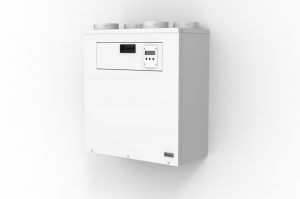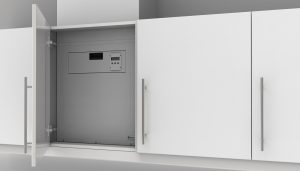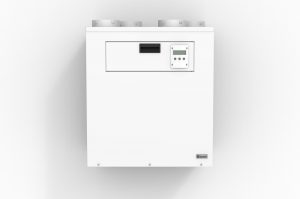
As Building Regulations continue to move us towards more airtight homes, Mechanical Ventilation with Heat Recovery (MVHR) systems are increasingly being considered the ideal choice, by architects, in new properties – and an increasingly popular one in refurbishments too. Lee Stones, category manager for Xpelair, looks at the factors which are driving a surge in the specification of heat recovery technology in the home.
It will come as no surprise to architects that specifying a good ventilation system has become as prevalent to property-owners as efficient home heating.
With increasingly stringent Building Regulations, a drive towards energy efficiency and increased insulation options for existing properties, homes ha
ve become more ‘wrapped up’ than ever before. Whilst these measures are ideal for reducing monthly heating bills, the lack of adequate ventilation can increase the presence of Volatile Organic Compounds (VOCs), mould and damp within the home, contributing to poor IAQ.
Couple this with many homeowners keeping their windows closed to avoid additional heating costs, security issues or road noise and it’s clear to see why the quality of air in our own homes is becoming an increasingly important health consideration throughout the UK.
Whole House Ventilation
Where the choice of ventilation is concerned, it’s no secret that whole house ventilation wins out in the efficiency stakes, and certainly for new build properties it’s a no brainer for housebuilders and architects to opt for whole house systems like Mechanical Ventilation with Heat Recovery (MVHR).
MVHR is ideal for new builds where insulation levels are high. Available as a centralised, whole-house system or single room units, this proven technology extracts moist, stale air from inside the property and replaces it with fresh, incoming air. Crucially, it uses heat from the outgoing air to warm the incoming air and high efficiency systems can recover up to 90 per cent of the heat that would have been lost through normal extraction.
Meeting regulations with ease
While following the Passive House model is voluntary, the design principles deriving from the pilot project set unprecedented standards of energy efficiency in residential building design. The good news for architects and housebuilders is that compliance is easy. Current Part F regs single out MVHR units, such as Xpelair’s new Natural Air 180, as the most sophisticated ventilation systems available.
Provided it is specified and installed properly, mechanical ventilation with heat recovery will ensure housebuilders can meet Building Regulations for new properties, whilst also improving SAP ratings. It’s no wonder this technology is proving so popular!
Energy credentials
One of the most obvious benefits of MVHR is its energy saving potential and this is a key factor in the rise of its specification in the new build sector. Using waste heat from the outgoing, stale air to warm fresh, incoming air can reduce heating bills, of course, and for those organisations with a large stock, it can deliver significant carbon reductions.
For the best results, MVHR systems such as Xpelair’s new Natural Air 180 – launching in April 2017 – can play a vital part in a whole-house approach to energy saving and carbon reduction, which includes an intelligent active humidistat that reacts in real-time to rapid increases in humidity – providing a boost, on demand. The flow rate in the Natural Air 180 is boosted only as needed, minimising energy costs and further reducing acoustic output.
Boost your IAQ
However, energy efficiency is not the only driving force behind the increasing specification of MVHR. We spend more than 90 per cent of our time indoors and whilst there is a global understanding of outdoor air pollution, few people realise that indoor air can be as much as 50 times more polluted than outdoor air.
Dust, pets and fumes from cookers or fireplaces, as well as drying clothes indoors and excess moisture from showering can all contribute to poor IAQ, which in turn can have a serious impact on our health.
The importance of IAQ should not be underestimated. Mould or condensation in the home can aggravate pre-existing health conditions such as asthma and eczema, whilst high levels of Volatile Organic Compounds (VOCs) from everyday household items such as polish or air fresheners can also lead to symptoms including fatigue, rhinitis, dizziness, headaches, coughing and sneezing.
According to a YouGov consumer survey, conducted on behalf of BEAMA, 58 per cent of UK adults have experienced mould or condensation in their homes and 19 per cent of those claim to have suffered from a respiratory or dermatological condition. The remaining 81 per cent are considered to be at risk.
The key, of course, is to ensure adequate ventilation in the home, reducing the build-up of condensation, black mould and the spores which it releases. The solution? A constant volume MVHR system. Xpelair’s Natural Air 180 uses Intelligent Adaptiflow Sensing to deliver constant volume performance. The motor operates by constantly assessing the performance of the impeller and, when there is a consistent change in airflow – caused by back pressure – the motor adjusts the speed of the fan to maintain a constant volume of extracted air.
What’s more, with the Internet of Things changing the face of the heating and ventilation industry, we can expect to see some exciting add-ons and integrations to MVHR systems in the coming months. By working closely with leading manufacturers such as Xpelair, architects can stay ahead of the game and take advantage of an exciting change for the industry.
Xpelair
Tel: 0844 372 7761
Email: [email protected]
Web: www.xpelair.co.uk



